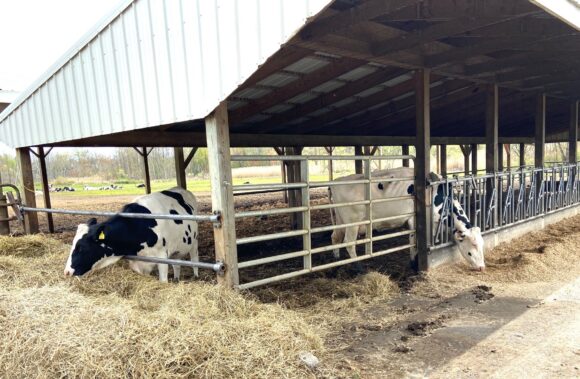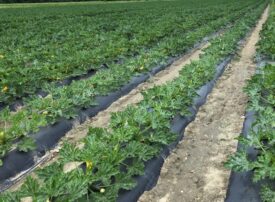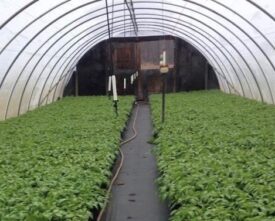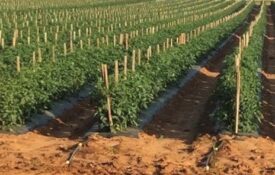
Dairy cows need milking at least twice a day and require nutritious feed. Feed is a costly input for farmers and in times when they cannot sell milk due to market chain disruptions, keeping the herd may not be an option. Photo credit: Michelle Infante-Casella
Why are there food shortages right now in certain areas? How can food be scarce when media reports reveal milk being dumped on the farm or at processing plants? Why are vegetable fields, ready to be harvested, being plowed under in Florida and California? The situation at first glance makes no sense. Why is the food that is being produced and plentiful not available where needed?

Zucchini squash is a major crop for spring in New Jersey. Farmers will begin squash harvests in late May in Southern New Jersey. Photo credit: Michelle Infante-Casella
The answer is sudden disruption of distribution channels as a result of COVID-19. The market vanished quickly with the widescale closures and service reductions across the commercial food industry. Essentially product demand has been lost or greatly reduced. Think back to basic economics. We now have low demand and an oversupply of product meant for the commercial food service industry. People still need to eat and are now turning to grocery stores and home-cooked meal options; all of which are facing shortages in supply. So why can’t farmers automatically redirect product and sell via the fresh wholesale market that distributes to grocery stores? While this sounds logical, it is not quite as easy as it sounds. Farmers and food processors may lack the ability to package produce and dairy products for retail markets. In addition, many do not have sales contacts to market product to an unfamiliar industry segment, even if demand exists. For vegetable farmers in states with crops in the ground, peak harvests began as the pandemic started. The food distribution systems did not have time to realign.
The produce industries in Florida and California are devastated with crops reaching harvest or already at the peak of harvest and no place to go. A high percentage of perishable produce grown in Florida and California is sold to the food service industry—restaurants, institutions, schools, hotels, etc. Those farmers generally do not have the ability to package produce for retail markets and lack sales distribution contacts to rapidly shift marketing outlets, even if there is a demand for those fresh items. Their only options were to destroy fields or donate product. Reports showed food donation sites in these states were inundated with fresh product that was highly perishable.

Tomato transplants are growing in the greenhouse and will soon be planted in fields for early July harvest. Photo credit: Michelle Infante-Casella
Dairy farmers are facing similar challenges as schools, restaurants and other food service providers closed as part of the effort to stop the spread of the corona virus. Factories that processed milk into cheese and other bulk dairy packaging for the food service industry have seen massive demand loss. Factories and processors who do package milk products for direct to the consumer sales are running low on packaging supplies for retail sales. And, since milk is perishable it cannot be held for a long period of time, thus it is being dumped. Generally, most milk makes it from the cow to grocery stores within 48 hours when the supply chain is working properly. The sudden shift in demand, for predominantly retail sales, has resulted in dairy farms having a surplus of milk. Farmers who produced for food service markets have lost demand from these closed or diminished market sectors.
Even with agriculture designated as essential and continuing to operate, some agricultural producers are facing devastating losses across some market segments. No one could have predicted such sudden market changes, with no warning for perishable farm products. It will require time to alter market distribution, packing and processing capabilities necessary to respond to the new realities caused by the pandemic.

Staked tomato fields are grown for fresh market tomato sales of the famous “Jersey Tomato”. Photo credit: Michelle Infante-Casella
Fortunately, many sectors of agriculture in New Jersey are not solely dependent on providing product to food service institutions. Garden State farmers tend to be more diverse and primarily sell to fresh market food distribution chains. In addition, many New Jersey farmers sell direct to the consumer through diverse retail, on-farm marketing methods.
New Jersey growers are now facing tough decisions on what and how many acres to plant for harvest this summer. As the harvest season in spring slowly starts with greens (lettuce, herbs, spinach, etc.) and then progresses to asparagus and strawberries, moving into cucumbers, summer squash, and other produce, farmers are concerned if supply and demand will align.
The harvest window for most fresh produce in New Jersey will start in late May and continue into fall. Dairy is a year-round production system. The industry faces uncertainty about what market conditions will look like in summer. Some speculate there will be some continuing demand loss from the food-service industry. Many in New Jersey hope the wholesale fresh market will absorb any excess produce and milk products intended for the local restaurant and institutional food industries, if necessary. Only time will tell and one thing is for sure – America needs farmers more than ever before.
By William Bamka, agricultural agent, Rutgers Cooperative Extension of Burlington County and Michelle Infante-Casella, agricultural agent, Rutgers Cooperative Extension of Gloucester County

